Project Management: Construction Project Planning & Work Sequencing
VerifiedAdded on 2023/04/03
|6
|837
|234
Project
AI Summary
This assignment provides a detailed overview of project management principles applied to a construction project, focusing on activities, work sequencing, and planning. It includes a precedence diagram illustrating the construction plan and discusses the critical path method for scheduling activities. The assignment outlines the major sequences of construction work, including excavation, concrete work, wall construction, roofing, fixing doors and windows, electrical and plumbing works, and final finishing. It also references the State Environmental Planning Policy (Affordable Rental Housing) 2009 in NSW, highlighting the context of affordable housing near major employment areas. The document emphasizes the importance of scheduling and managing tasks to ensure project completion within the planned duration, with the project manager prioritizing critical tasks to keep the project on schedule. Desklib offers this and many other assignments for students.
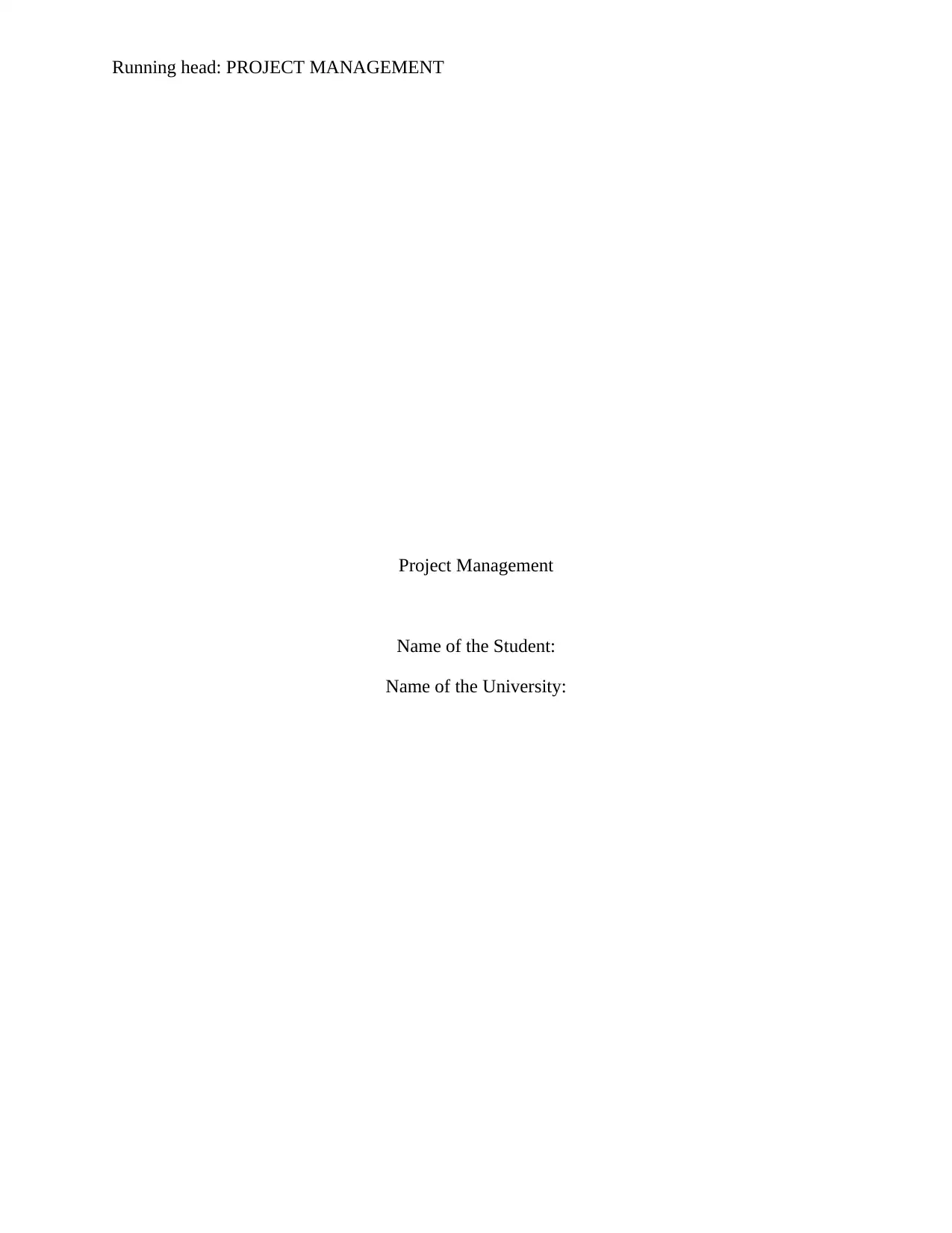
Running head: PROJECT MANAGEMENT
Project Management
Name of the Student:
Name of the University:
Project Management
Name of the Student:
Name of the University:
Paraphrase This Document
Need a fresh take? Get an instant paraphrase of this document with our AI Paraphraser
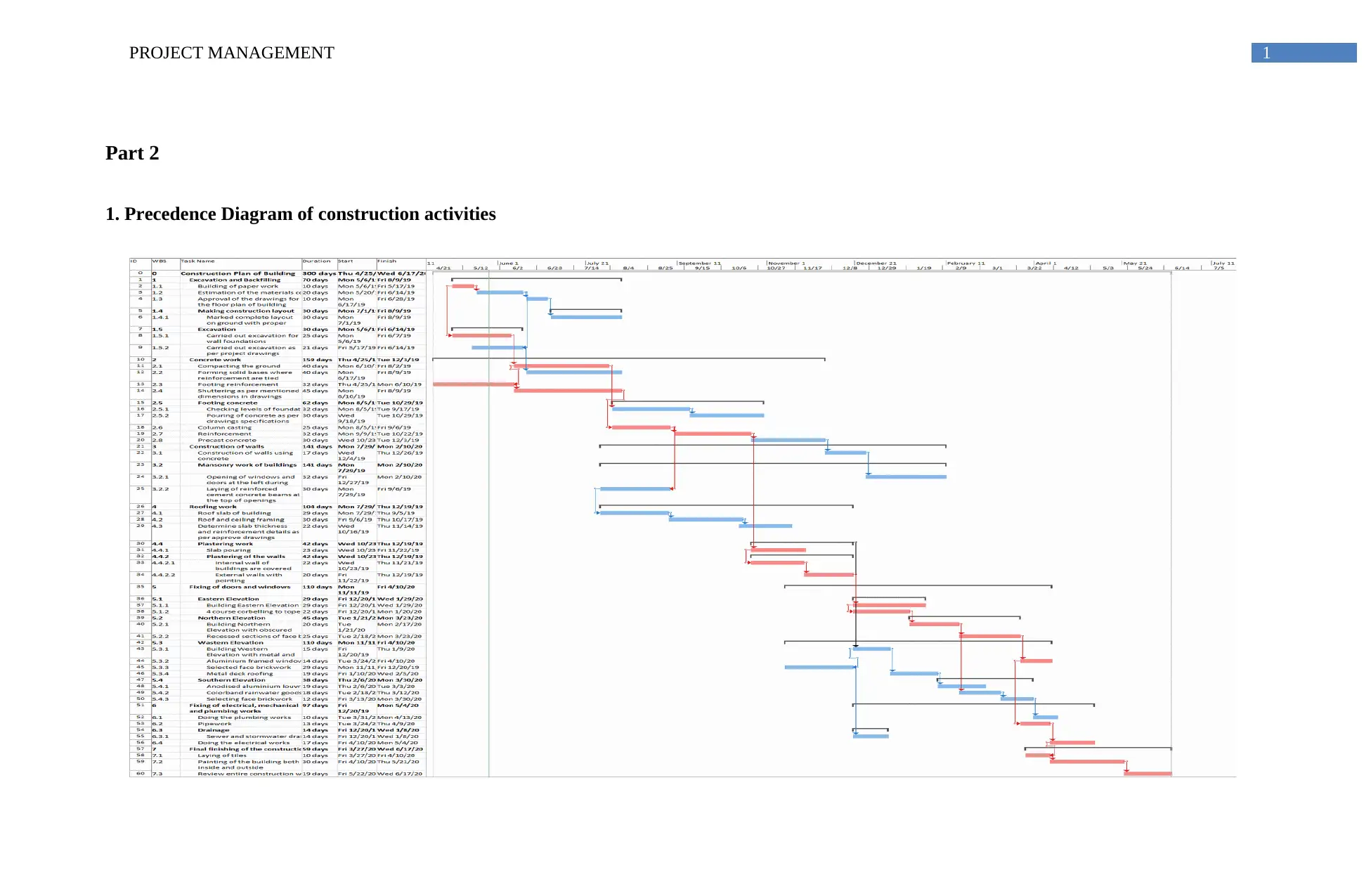
1PROJECT MANAGEMENT
Part 2
1. Precedence Diagram of construction activities
Part 2
1. Precedence Diagram of construction activities
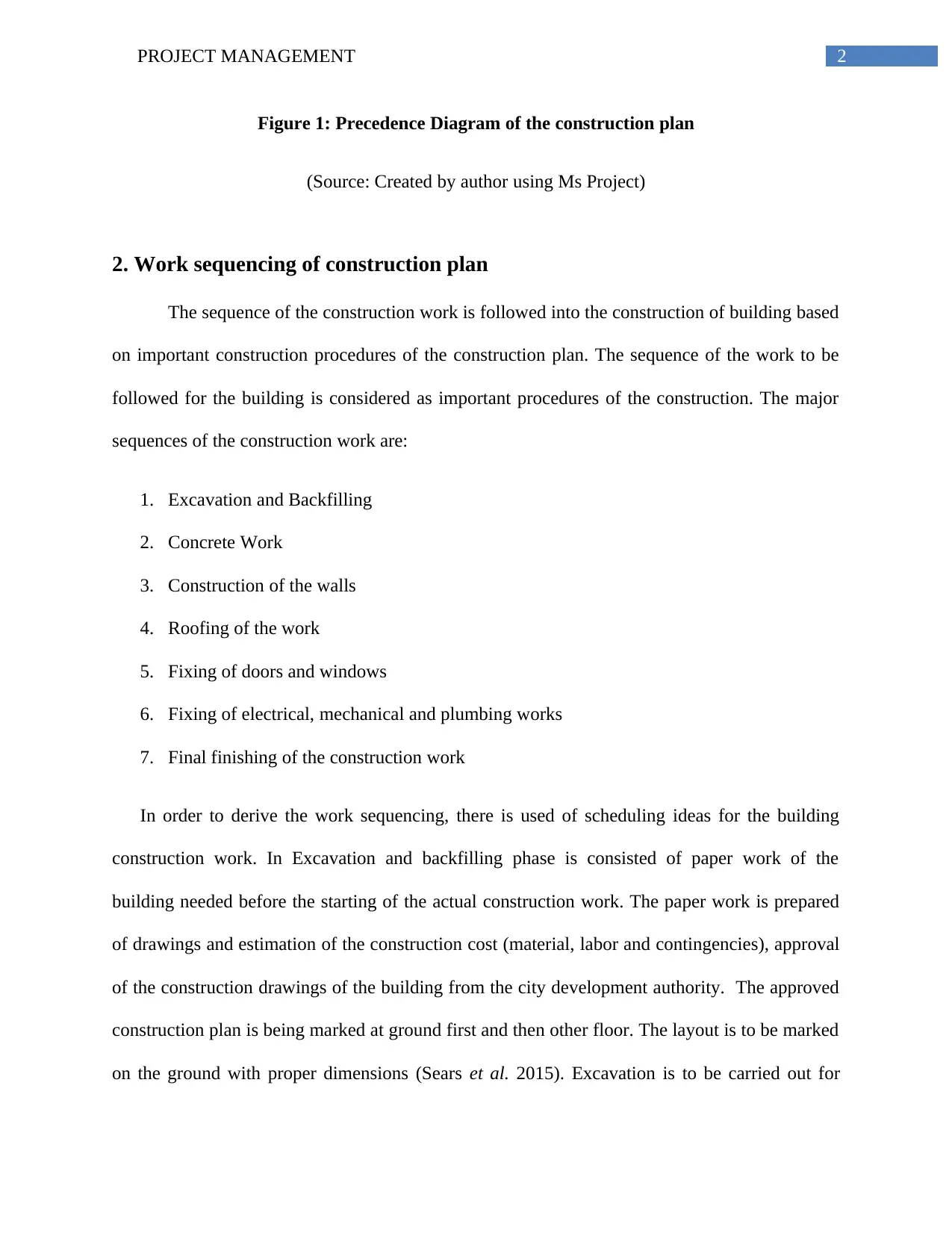
2PROJECT MANAGEMENT
Figure 1: Precedence Diagram of the construction plan
(Source: Created by author using Ms Project)
2. Work sequencing of construction plan
The sequence of the construction work is followed into the construction of building based
on important construction procedures of the construction plan. The sequence of the work to be
followed for the building is considered as important procedures of the construction. The major
sequences of the construction work are:
1. Excavation and Backfilling
2. Concrete Work
3. Construction of the walls
4. Roofing of the work
5. Fixing of doors and windows
6. Fixing of electrical, mechanical and plumbing works
7. Final finishing of the construction work
In order to derive the work sequencing, there is used of scheduling ideas for the building
construction work. In Excavation and backfilling phase is consisted of paper work of the
building needed before the starting of the actual construction work. The paper work is prepared
of drawings and estimation of the construction cost (material, labor and contingencies), approval
of the construction drawings of the building from the city development authority. The approved
construction plan is being marked at ground first and then other floor. The layout is to be marked
on the ground with proper dimensions (Sears et al. 2015). Excavation is to be carried out for
Figure 1: Precedence Diagram of the construction plan
(Source: Created by author using Ms Project)
2. Work sequencing of construction plan
The sequence of the construction work is followed into the construction of building based
on important construction procedures of the construction plan. The sequence of the work to be
followed for the building is considered as important procedures of the construction. The major
sequences of the construction work are:
1. Excavation and Backfilling
2. Concrete Work
3. Construction of the walls
4. Roofing of the work
5. Fixing of doors and windows
6. Fixing of electrical, mechanical and plumbing works
7. Final finishing of the construction work
In order to derive the work sequencing, there is used of scheduling ideas for the building
construction work. In Excavation and backfilling phase is consisted of paper work of the
building needed before the starting of the actual construction work. The paper work is prepared
of drawings and estimation of the construction cost (material, labor and contingencies), approval
of the construction drawings of the building from the city development authority. The approved
construction plan is being marked at ground first and then other floor. The layout is to be marked
on the ground with proper dimensions (Sears et al. 2015). Excavation is to be carried out for
⊘ This is a preview!⊘
Do you want full access?
Subscribe today to unlock all pages.

Trusted by 1+ million students worldwide
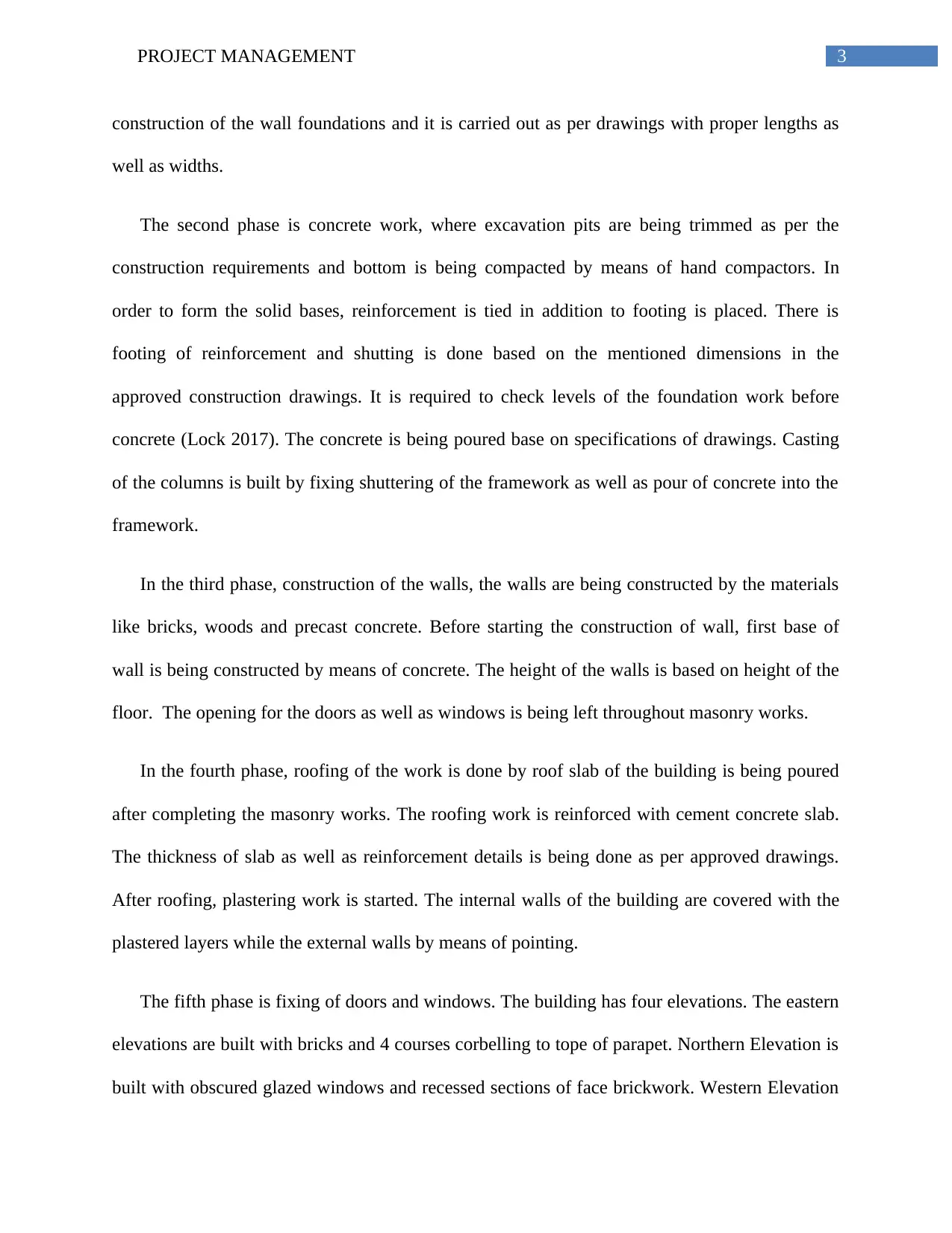
3PROJECT MANAGEMENT
construction of the wall foundations and it is carried out as per drawings with proper lengths as
well as widths.
The second phase is concrete work, where excavation pits are being trimmed as per the
construction requirements and bottom is being compacted by means of hand compactors. In
order to form the solid bases, reinforcement is tied in addition to footing is placed. There is
footing of reinforcement and shutting is done based on the mentioned dimensions in the
approved construction drawings. It is required to check levels of the foundation work before
concrete (Lock 2017). The concrete is being poured base on specifications of drawings. Casting
of the columns is built by fixing shuttering of the framework as well as pour of concrete into the
framework.
In the third phase, construction of the walls, the walls are being constructed by the materials
like bricks, woods and precast concrete. Before starting the construction of wall, first base of
wall is being constructed by means of concrete. The height of the walls is based on height of the
floor. The opening for the doors as well as windows is being left throughout masonry works.
In the fourth phase, roofing of the work is done by roof slab of the building is being poured
after completing the masonry works. The roofing work is reinforced with cement concrete slab.
The thickness of slab as well as reinforcement details is being done as per approved drawings.
After roofing, plastering work is started. The internal walls of the building are covered with the
plastered layers while the external walls by means of pointing.
The fifth phase is fixing of doors and windows. The building has four elevations. The eastern
elevations are built with bricks and 4 courses corbelling to tope of parapet. Northern Elevation is
built with obscured glazed windows and recessed sections of face brickwork. Western Elevation
construction of the wall foundations and it is carried out as per drawings with proper lengths as
well as widths.
The second phase is concrete work, where excavation pits are being trimmed as per the
construction requirements and bottom is being compacted by means of hand compactors. In
order to form the solid bases, reinforcement is tied in addition to footing is placed. There is
footing of reinforcement and shutting is done based on the mentioned dimensions in the
approved construction drawings. It is required to check levels of the foundation work before
concrete (Lock 2017). The concrete is being poured base on specifications of drawings. Casting
of the columns is built by fixing shuttering of the framework as well as pour of concrete into the
framework.
In the third phase, construction of the walls, the walls are being constructed by the materials
like bricks, woods and precast concrete. Before starting the construction of wall, first base of
wall is being constructed by means of concrete. The height of the walls is based on height of the
floor. The opening for the doors as well as windows is being left throughout masonry works.
In the fourth phase, roofing of the work is done by roof slab of the building is being poured
after completing the masonry works. The roofing work is reinforced with cement concrete slab.
The thickness of slab as well as reinforcement details is being done as per approved drawings.
After roofing, plastering work is started. The internal walls of the building are covered with the
plastered layers while the external walls by means of pointing.
The fifth phase is fixing of doors and windows. The building has four elevations. The eastern
elevations are built with bricks and 4 courses corbelling to tope of parapet. Northern Elevation is
built with obscured glazed windows and recessed sections of face brickwork. Western Elevation
Paraphrase This Document
Need a fresh take? Get an instant paraphrase of this document with our AI Paraphraser
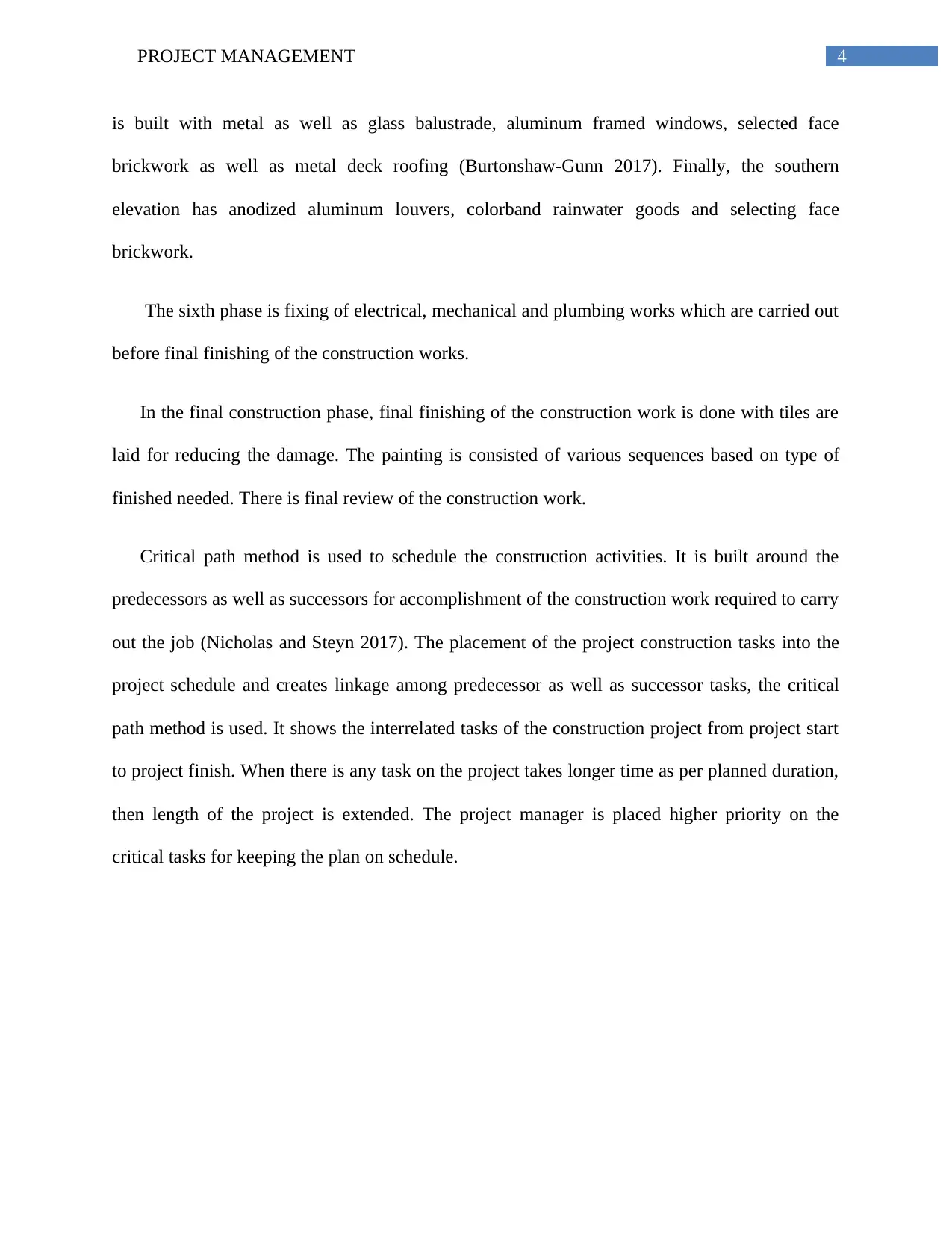
4PROJECT MANAGEMENT
is built with metal as well as glass balustrade, aluminum framed windows, selected face
brickwork as well as metal deck roofing (Burtonshaw-Gunn 2017). Finally, the southern
elevation has anodized aluminum louvers, colorband rainwater goods and selecting face
brickwork.
The sixth phase is fixing of electrical, mechanical and plumbing works which are carried out
before final finishing of the construction works.
In the final construction phase, final finishing of the construction work is done with tiles are
laid for reducing the damage. The painting is consisted of various sequences based on type of
finished needed. There is final review of the construction work.
Critical path method is used to schedule the construction activities. It is built around the
predecessors as well as successors for accomplishment of the construction work required to carry
out the job (Nicholas and Steyn 2017). The placement of the project construction tasks into the
project schedule and creates linkage among predecessor as well as successor tasks, the critical
path method is used. It shows the interrelated tasks of the construction project from project start
to project finish. When there is any task on the project takes longer time as per planned duration,
then length of the project is extended. The project manager is placed higher priority on the
critical tasks for keeping the plan on schedule.
is built with metal as well as glass balustrade, aluminum framed windows, selected face
brickwork as well as metal deck roofing (Burtonshaw-Gunn 2017). Finally, the southern
elevation has anodized aluminum louvers, colorband rainwater goods and selecting face
brickwork.
The sixth phase is fixing of electrical, mechanical and plumbing works which are carried out
before final finishing of the construction works.
In the final construction phase, final finishing of the construction work is done with tiles are
laid for reducing the damage. The painting is consisted of various sequences based on type of
finished needed. There is final review of the construction work.
Critical path method is used to schedule the construction activities. It is built around the
predecessors as well as successors for accomplishment of the construction work required to carry
out the job (Nicholas and Steyn 2017). The placement of the project construction tasks into the
project schedule and creates linkage among predecessor as well as successor tasks, the critical
path method is used. It shows the interrelated tasks of the construction project from project start
to project finish. When there is any task on the project takes longer time as per planned duration,
then length of the project is extended. The project manager is placed higher priority on the
critical tasks for keeping the plan on schedule.
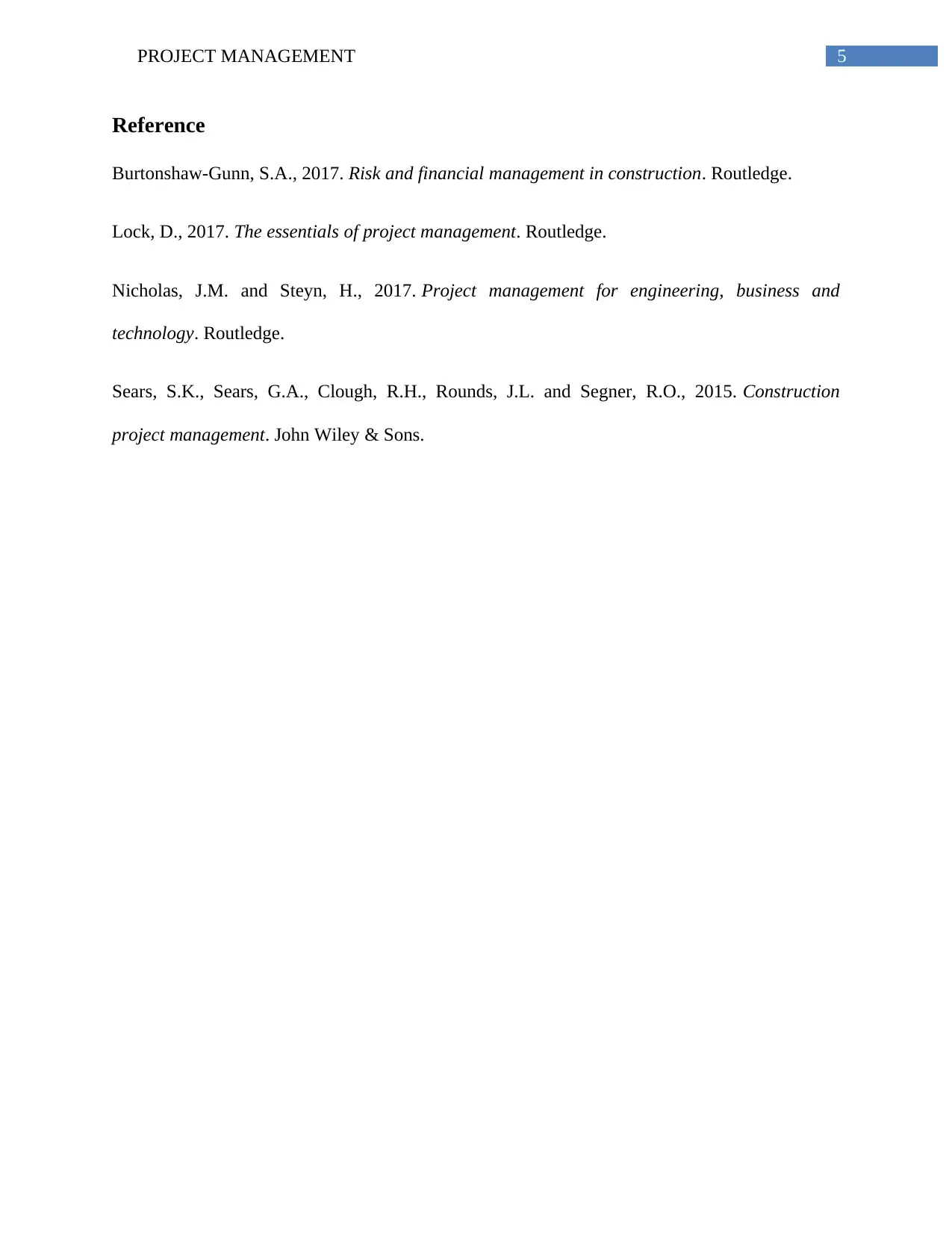
5PROJECT MANAGEMENT
Reference
Burtonshaw-Gunn, S.A., 2017. Risk and financial management in construction. Routledge.
Lock, D., 2017. The essentials of project management. Routledge.
Nicholas, J.M. and Steyn, H., 2017. Project management for engineering, business and
technology. Routledge.
Sears, S.K., Sears, G.A., Clough, R.H., Rounds, J.L. and Segner, R.O., 2015. Construction
project management. John Wiley & Sons.
Reference
Burtonshaw-Gunn, S.A., 2017. Risk and financial management in construction. Routledge.
Lock, D., 2017. The essentials of project management. Routledge.
Nicholas, J.M. and Steyn, H., 2017. Project management for engineering, business and
technology. Routledge.
Sears, S.K., Sears, G.A., Clough, R.H., Rounds, J.L. and Segner, R.O., 2015. Construction
project management. John Wiley & Sons.
⊘ This is a preview!⊘
Do you want full access?
Subscribe today to unlock all pages.

Trusted by 1+ million students worldwide
1 out of 6
Related Documents
Your All-in-One AI-Powered Toolkit for Academic Success.
+13062052269
info@desklib.com
Available 24*7 on WhatsApp / Email
![[object Object]](/_next/static/media/star-bottom.7253800d.svg)
Unlock your academic potential
Copyright © 2020–2025 A2Z Services. All Rights Reserved. Developed and managed by ZUCOL.





